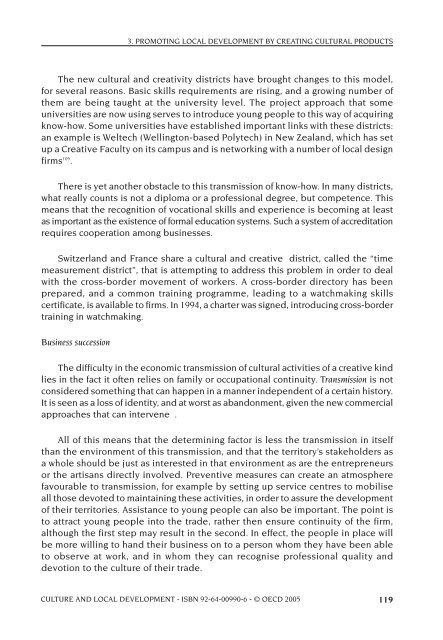OECD Culture and Local Development.pdf - PACA
OECD Culture and Local Development.pdf - PACA
OECD Culture and Local Development.pdf - PACA
Create successful ePaper yourself
Turn your PDF publications into a flip-book with our unique Google optimized e-Paper software.
3. PROMOTING LOCAL DEVELOPMENT BY CREATING CULTURAL PRODUCTS<br />
The new cultural <strong>and</strong> creativity districts have brought changes to this model,<br />
for several reasons. Basic skills requirements are rising, <strong>and</strong> a growing number of<br />
them are being taught at the university level. The project approach that some<br />
universities are now using serves to introduce young people to this way of acquiring<br />
know-how. Some universities have established important links with these districts:<br />
an example is Weltech (Wellington-based Polytech) in New Zeal<strong>and</strong>, which has set<br />
up a Creative Faculty on its campus <strong>and</strong> is networking with a number of local design<br />
firms 105 .<br />
There is yet another obstacle to this transmission of know-how. In many districts,<br />
what really counts is not a diploma or a professional degree, but competence. This<br />
means that the recognition of vocational skills <strong>and</strong> experience is becoming at least<br />
as important as the existence of formal education systems. Such a system of accreditation<br />
requires cooperation among businesses.<br />
Switzerl<strong>and</strong> <strong>and</strong> France share a cultural <strong>and</strong> creative district, called the “time<br />
measurement district”, that is attempting to address this problem in order to deal<br />
with the cross-border movement of workers. A cross-border directory has been<br />
prepared, <strong>and</strong> a common training programme, leading to a watchmaking skills<br />
certificate, is available to firms. In 1994, a charter was signed, introducing cross-border<br />
training in watchmaking.<br />
Business succession<br />
The difficulty in the economic transmission of cultural activities of a creative kind<br />
lies in the fact it often relies on family or occupational continuity. Transmission is not<br />
considered something that can happen in a manner independent of a certain history.<br />
It is seen as a loss of identity, <strong>and</strong> at worst as ab<strong>and</strong>onment, given the new commercial<br />
approaches that can intervene .<br />
All of this means that the determining factor is less the transmission in itself<br />
than the environment of this transmission, <strong>and</strong> that the territory’s stakeholders as<br />
a whole should be just as interested in that environment as are the entrepreneurs<br />
or the artisans directly involved. Preventive measures can create an atmosphere<br />
favourable to transmission, for example by setting up service centres to mobilise<br />
all those devoted to maintaining these activities, in order to assure the development<br />
of their territories. Assistance to young people can also be important. The point is<br />
to attract young people into the trade, rather then ensure continuity of the firm,<br />
although the first step may result in the second. In effect, the people in place will<br />
be more willing to h<strong>and</strong> their business on to a person whom they have been able<br />
to observe at work, <strong>and</strong> in whom they can recognise professional quality <strong>and</strong><br />
devotion to the culture of their trade.<br />
CULTURE AND LOCAL DEVELOPMENT - ISBN 92-64-00990-6 - © <strong>OECD</strong> 2005 119














